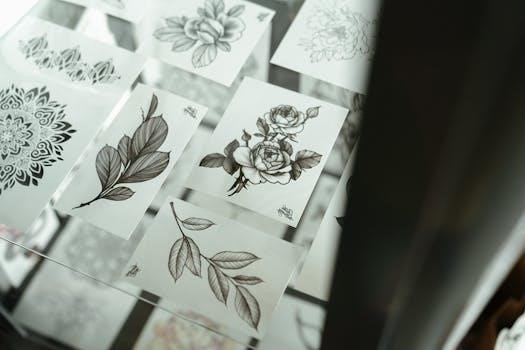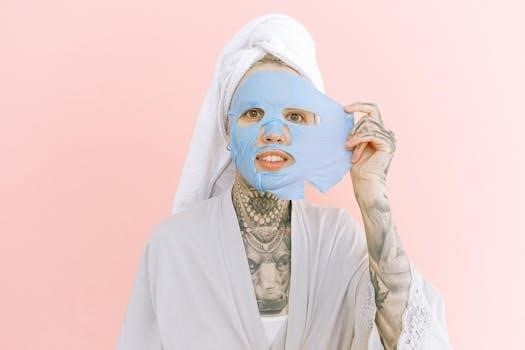
tattoo aftercare instructions sheet
Tattoo aftercare is essential for proper healing․
This sheet provides guidelines on how to care for your new tattoo, to prevent infection, and ensure vibrant colors․
Follow these instructions diligently for optimal results and a long-lasting, beautiful work of art․
Importance of Tattoo Aftercare
Tattoo aftercare is paramount, directly impacting the healing process, long-term appearance, and health․
Neglecting proper aftercare can lead to complications, including infections, scarring, and ink rejection․
The first few weeks after getting a tattoo are crucial, and diligent aftercare significantly reduces the risk of adverse reactions․
Proper aftercare ensures the tattoo heals quickly and evenly, preserving the artist’s intended design and colors․
Furthermore, consistent aftercare keeps the skin moisturized, preventing dryness and cracking, which can damage the tattoo․
By adhering to aftercare instructions, you’re safeguarding your investment and maintaining the integrity of your body art․
Think of aftercare as an extension of the tattooing process, crucial for achieving the best possible outcome․
It’s also important to follow the tattoo artist’s specific instructions, as they are tailored to the individual tattoo and skin type․
Remember, a well-cared-for tattoo remains vibrant and beautiful for years, reflecting your commitment to its longevity․
Prioritizing aftercare guarantees that your tattoo remains a source of pride, rather than a source of regret․
Immediate Aftercare⁚ The First 48 Hours

The initial 48 hours after getting a tattoo are critical for setting the stage for proper healing․
During this period, focus on keeping the tattoo clean, protected, and moisturized․
Typically, the tattoo artist will apply a bandage or protective film․
Leave this bandage on for the recommended time, usually 2-24 hours, as directed by your artist․
After removing the bandage, gently wash the tattoo with mild, unscented antibacterial soap and lukewarm water․
Pat the area dry with a clean paper towel, avoiding any rubbing or friction․
Apply a thin layer of recommended tattoo aftercare ointment or balm to keep the tattoo moisturized․
Avoid petroleum-based products, as they can clog pores and hinder healing․
Repeat the washing and moisturizing process 2-3 times daily․
Wear loose-fitting clothing to prevent irritation and allow air circulation․
Avoid direct sunlight, soaking in water, and strenuous activities․
Be vigilant about keeping the area clean to minimize the risk of infection․
Monitor the tattoo for any signs of excessive redness, swelling, or discharge, and consult your artist or a healthcare professional if concerned․
Removing the Bandage⁚ Timing and Procedure
Proper timing and technique are crucial when removing the initial bandage from your new tattoo․
The duration the bandage should remain on varies depending on the type of bandage used and the artist’s instructions․
Generally, traditional bandages should be removed after a minimum of 2 hours, but no longer than 24 hours․
Saniderm or second-skin type bandages can be left on for several days, as advised by your artist․
Before removing the bandage, wash your hands thoroughly with soap and water to prevent introducing bacteria to the area․
Carefully peel the bandage away from the skin, starting at one corner and gently pulling in the direction of hair growth․
If the bandage sticks to the tattoo, moisten it with lukewarm water to loosen the adhesive․
Avoid ripping or tearing the bandage, as this can damage the tattoo and surrounding skin․
Once the bandage is removed, inspect the tattoo for any signs of irritation or infection․
Gently wash the area with mild, unscented antibacterial soap and lukewarm water to remove any residual adhesive or ink․
Pat the tattoo dry with a clean paper towel and proceed with the recommended aftercare routine, including moisturizing․
If you experience any difficulty or discomfort during the bandage removal process, consult your tattoo artist for guidance․
Washing the Tattoo⁚ Soap and Technique
Washing your new tattoo is a critical step in the healing process, removing bacteria and preventing infection․
Begin by washing your hands thoroughly with soap and water before touching your tattoo․
Use lukewarm water and a mild, fragrance-free, antibacterial soap to gently cleanse the area․
Avoid using harsh soaps, as they can irritate the skin and delay healing․
Lather the soap in your hands and gently apply it to the tattoo using your fingertips․
Do not use a washcloth or sponge, as they can harbor bacteria and damage the delicate skin․
Gently massage the soap over the tattoo in a circular motion to remove any blood, plasma, or excess ink․
Rinse the tattoo thoroughly with lukewarm water to remove all traces of soap․
Ensure that no soap residue remains, as it can cause irritation and dryness․
Pat the tattoo dry with a clean paper towel․
Do not rub the tattoo, as this can damage the skin and disrupt the healing process․
Allow the tattoo to air dry for a few minutes before applying a thin layer of moisturizer․
Wash your tattoo 2-3 times a day during the healing process, or as directed by your tattoo artist․
Consistent and gentle washing is key to preventing infection and promoting proper healing․
Moisturizing⁚ Choosing the Right Products
Moisturizing is paramount in tattoo aftercare, keeping the skin hydrated and promoting proper healing․
Choosing the right product is crucial to avoid irritation and potential allergic reactions․
Opt for fragrance-free, alcohol-free lotions or balms specifically designed for tattoo aftercare․
These products are formulated to be gentle on sensitive skin and minimize the risk of complications․
Avoid using petroleum-based products, such as Vaseline, as they can trap moisture and bacteria, potentially leading to infection․
Instead, look for products containing natural ingredients like shea butter, cocoa butter, or vitamin E, which can help soothe and nourish the skin․
Apply a thin layer of moisturizer to the tattoo after each washing, or whenever the skin feels dry․
Gently massage the moisturizer into the skin until it is fully absorbed․
Avoid over-moisturizing, as this can also trap moisture and hinder the healing process․
A thin, even layer is all that is needed to keep the skin hydrated and supple․
Continue moisturizing the tattoo throughout the healing process, typically for 2-4 weeks, or as directed by your tattoo artist․
Proper moisturizing will help prevent scabbing, itching, and dryness, ensuring a vibrant and long-lasting tattoo․
What to Avoid⁚ Common Mistakes in Tattoo Aftercare
Avoiding common mistakes in tattoo aftercare is crucial for proper healing and preventing complications․
One of the most frequent errors is picking or scratching at the tattoo, which can lead to infection, scarring, and ink loss․
It is essential to resist the urge to touch the tattoo unnecessarily․
Another common mistake is exposing the new tattoo to direct sunlight, which can fade the ink and damage the skin․
Always protect your tattoo with clothing or a high-SPF sunscreen when outdoors․
Soaking the tattoo in water, such as swimming or taking long baths, should also be avoided, as it can increase the risk of infection and disrupt the healing process․
Additionally, using harsh soaps or cleaning products on the tattoo can irritate the skin and delay healing․
Opt for gentle, fragrance-free cleansers specifically designed for tattoo aftercare․
Over-moisturizing the tattoo is another mistake, as it can trap moisture and bacteria, potentially leading to infection․
Apply a thin layer of moisturizer only when the skin feels dry․
Finally, neglecting to follow your tattoo artist’s aftercare instructions can significantly impact the healing process and the overall appearance of your tattoo․
Adhering to these guidelines will help ensure a smooth and successful healing experience․
Preventing Infection⁚ Signs and Actions
Preventing infection is a top priority in tattoo aftercare․
Recognizing the signs of infection early and taking appropriate action can prevent serious complications․
Common signs of a tattoo infection include excessive redness, swelling, and persistent pain beyond the initial days of healing․
Pus or fluid discharge from the tattoo area is a clear indication of infection and requires immediate attention․
Other signs may include a foul odor, fever, chills, or swollen lymph nodes near the tattoo site․
If you suspect an infection, it’s crucial to avoid self-treating and seek medical advice from a healthcare professional immediately․
Do not apply over-the-counter antibiotics or ointments without consulting a doctor․
To prevent infection, always wash your hands thoroughly before touching your new tattoo․
Clean the tattoo gently with mild, unscented antibacterial soap and lukewarm water, patting it dry with a clean paper towel․
Avoid soaking the tattoo in water or exposing it to unsanitary environments․
Wear loose-fitting clothing to allow airflow and prevent irritation․
Follow your tattoo artist’s aftercare instructions carefully and use recommended products․
By being vigilant and proactive, you can significantly reduce the risk of infection and ensure your tattoo heals properly․
Healing Stages⁚ What to Expect Day by Day
Understanding the healing stages of a tattoo can help manage expectations and ensure proper aftercare․
In the first few days, the tattoo will be tender, red, and may have a slight oozing of ink and plasma․
This is normal and part of the initial healing process․
Around days 3-7, the tattoo will start to form a thin layer of scabbing․
It is crucial not to pick or scratch at these scabs, as this can damage the tattoo and increase the risk of infection․
During the second week, the scabs will begin to flake off naturally;
The skin underneath may appear shiny or milky․
Continue moisturizing the tattoo to keep the skin hydrated and promote healing․
By weeks 3-4, most of the scabbing should be gone, and the tattoo will appear less vibrant․

This is because a new layer of skin is forming over the ink․
Over the next few months, the colors will gradually return to their full vibrancy as the skin fully heals․
It is important to note that healing times can vary depending on individual factors and tattoo size and placement․
Throughout the healing process, continue to follow your tattoo artist’s aftercare instructions and protect your tattoo from sun exposure and irritation․
Long-Term Care⁚ Protecting Your Tattoo
Long-term care is essential to keep your tattoo looking vibrant․
Sun protection is crucial; UV rays can fade the ink over time․
Apply a high SPF sunscreen to the tattoo whenever exposed to the sun․
Choose a sunscreen specifically designed for tattoos or sensitive skin․
Regular moisturizing helps maintain skin elasticity and color vibrancy․
Use a fragrance-free lotion to keep the skin hydrated․
Avoid harsh chemicals and abrasive cleansers on the tattooed area․
These can irritate the skin and fade the ink․
Stay hydrated by drinking plenty of water․
Proper hydration keeps skin healthy and supple․
Avoid excessive rubbing or friction on the tattoo․
Tight clothing or jewelry can cause irritation․
Consider using tattoo balms or lotions․
These products are formulated to nourish and protect tattooed skin․
If you notice any changes in your tattoo, like fading or blurring, consult with your tattoo artist․
Touch-ups may be necessary to restore the tattoo‘s original appearance․
Consistent care will keep your tattoo looking its best for years․
Specific Aftercare for Eyebrows
Eyebrow tattoos, also known as microblading or permanent makeup, require specific aftercare due to the delicate nature of the area․
Immediately after the procedure, gently blot the eyebrows with a clean tissue to remove excess lymph fluid․
Avoid wetting the eyebrows for the first 24 hours to allow the pigment to set․
After 24 hours, gently wash the eyebrows with a mild, fragrance-free cleanser and pat dry․
Apply a thin layer of the recommended aftercare ointment to keep the area moisturized․
Avoid using petroleum-based products, as they can clog pores and affect the ink․
Do not pick at any scabs that form, as this can cause pigment loss and scarring․
Avoid direct sunlight, tanning beds, and excessive sweating for at least two weeks․
When showering, avoid direct water pressure on the eyebrows․
Do not apply makeup or skincare products to the eyebrows until they are fully healed․
Sleep on your back to prevent pressure and friction on the eyebrows․
Follow your artist’s specific instructions for aftercare, as they may vary depending on the technique used․
Attend any scheduled touch-up appointments to ensure the best results․
Proper aftercare will help ensure the longevity and appearance of your eyebrow tattoo․
When to Seek Medical Attention
While proper tattoo aftercare can prevent most complications, it’s essential to know when to seek medical attention․
If you experience signs of infection, such as excessive redness, swelling, pain, or pus, consult a doctor immediately․
A fever or chills may also indicate an infection requiring medical treatment․
If you notice red streaks radiating from the tattoo, this is a sign of a serious infection that needs immediate attention․
Allergic reactions to the ink can also occur, causing itching, rash, or hives․
If you experience difficulty breathing or swelling of the face or throat, seek emergency medical care․
If the tattoo area becomes excessively warm to the touch, this could be another sign of infection․
If you have any concerns about the healing process or notice any unusual changes, it’s always best to consult a healthcare professional․

Do not attempt to self-treat any potential infections or allergic reactions․
Seeking prompt medical attention can prevent serious complications and ensure proper healing․
Be sure to inform your doctor about the tattoo and the type of ink used, as this information can help with diagnosis and treatment․
Following your tattoo artist’s aftercare instructions is crucial, but don’t hesitate to seek medical advice if needed․
Your health and well-being are the top priority․
Tattoo Aftercare Products Recommendations
Choosing the right products is crucial for proper tattoo aftercare․

Opt for fragrance-free, alcohol-free, and hypoallergenic options to minimize irritation․
Unscented antibacterial soap, like Dial Gold or Dove, is recommended for gently cleaning the tattoo․
Avoid harsh soaps that can dry out the skin․
For moisturizing, consider using specialized tattoo aftercare balms or lotions․
These products are designed to promote healing and prevent infection․
Look for ingredients like shea butter, cocoa butter, or vitamin E, which can help soothe and hydrate the skin․
Aquaphor is a popular choice for the initial healing stages, but use it sparingly to avoid clogging pores․
Once the tattoo starts to flake, switch to a lighter lotion like Lubriderm or Eucerin․
Avoid products containing petroleum jelly, as they can trap bacteria and hinder healing․
Sunscreen is essential for protecting your tattoo from fading․
Choose a broad-spectrum sunscreen with an SPF of 30 or higher․
Apply sunscreen liberally to the tattoo whenever exposed to sunlight․
Consult your tattoo artist or dermatologist for specific product recommendations based on your skin type and the tattoo‘s location․
Always patch-test new products on a small area of skin before applying them to the entire tattoo․